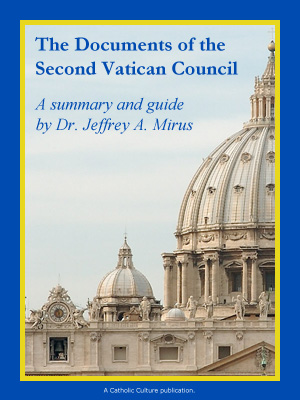Cloistered: The Inside Story
By Dr. Jeff Mirus ( bio - articles - email ) | Mar 10, 2014 | In Reviews
It is very interesting to see how secular publishers deal with our contemporary cultural objection to serious religious engagement. An author cannot advocate Christianity, but he can do a study of somebody else’s theology. An author cannot urge fallen-away Catholics to return to the Church, but he can do a study of why some people do return to the Church. And an author certainly cannot advocate that people retire from the world and become cloistered nuns, but she can do a study of the attitudes and motivations of the nuns in one particular house of the Poor Clare Colettines.
Free eBook:

|
| Free eBook: The Documents of Vatican II |
Sociology, of course, is the new way to study anything you want without getting into ideological trouble. Thus, for example, Oxford University Press has announced a new book entitled Becoming Catholic: Finding Rome in the American Religious Landscape. Author David Yamane explores the phenomenon of Catholic conversion, intrigued by the two million Americans who have entered the Church through the Rite of Christian Initiation for Adults since 1988. According to Yamane, about 150,000 Americans join the Catholic Church each year, and more than one in fifty American adults is a convert. So there is room for some sociology here.
There is a similar opportunity in another OUP title published in March, Young Catholic America: Emerging Adults In, Out of, and Gone from the Church. This has no fewer than four co-authors. I haven’t read this book, and Yamane’s book will not be released until April 1st (an inauspicious date), but I have just finished reading another Oxford offering, Dedicated to God by Abbie Reese, which explores the members of the Poor Clare Colettine community in the Corpus Christi monastery in Rockford, Illinois. Sociology is not quite the discipline for tiny groups like this, so what Abbie Reese does is really oral history, which provides the same academic insulation. It is not broad and statistical in nature, but rather seeks to open a window on a particular lifestyle by getting its practitioners to reveal themselves and their stories.
Well, God knows that cloistered contemplation a a lifestyle which is little understood today, and even less appreciated.
Reese describes herself as one who was introduced to religion by her Protestant parents and who developed a keen interest in “other cultures” partly because a high school teacher interested her in folklore from around the world. The cover bio describes her as “an independent scholar and interdisciplinary artist who utilizes oral history and ethnographic methodologies to explore individual and cultural identity.” This explains the subtitle, “An Oral History of Cloistered Nuns”, and the book certainly does feature outstanding black-and-white photographs of the nuns in situ. But surely all this academic posturing, so characteristic of our contemporary world, borders on the absurd. It tells its own story, the story of moth-like publishers, darting around the flame, afraid of getting burned.
Still a Good Book
It goes without saying that the advertising flyer for the book claims there is a startlingly wide variety of beliefs among the nuns profiled in Dedicated to God. But as you would expect, this is not true. These women simply have different personalities and, to her credit, the author does not try to justify the ad copy in her work, as a lesser soul might have done. No, in this case, the author’s “academic cover” actually permits a wonderfully accurate portrait to be painted. Anyone who feels called to the contemplative life can benefit immensely from Reese’s detailed and sensitive study of these cloistered women. The author succeeded in winning the nuns’ affections, gaining permission to spend a good deal of time interviewing them and observing them over a period of years, and writing up their stories. It is important to note, however, that Reese preserves the nuns’ anonymity by using fictitious religious and family names.
Reese organizes the book in a highly interesting way. She divides her work into three parts, entitled “The Call”, “The Life”, and “The Threats”. Each chapter focuses on a particular aspect of the cloistered contemplative life, and each chapter contains an expository section by the author followed by the first-person story of one of the nuns. Because each nun’s story inevitably focuses on the call that led that particular woman to the Corpus Christi monastery, the theme of the Divine call is far and away the strongest and most important in the book. It is also what makes the book so valuable, especially to women who may wonder if they are experiencing the same call. Twelve different religious participated in the interviews; eight of them tell their story directly.
Or perhaps not quite directly. Through an intriguing process of unconscious literary analysis, I gradually noticed that the different women sounded remarkably similar. I do not mean they recounted the same lives or responded to their callings in exactly the same ways. I mean their manner of speech was surprisingly similar. It soon became clear that these personal stories were reconstructed by the author from less cohesive interviews, and that the author lacks the not insignificant literary talent it takes to recreate the individual voices. Yes, there are some differences in style among the nuns, and even a few notable differences. But there is also a strong commonality, a kind of trick of repetition which makes the nuns sound somewhat less well-spoken and more childish than they actually are.
Whenever a personal story is recounted, a repetitive pattern emerges in the woman’s speech. Consider just a few examples:
- Sister Joan Marie of the Child Jesus: “My mother was home all the time. She was always home.”
- Sister Mary Joseph (speaking of her birth-sister): “Mary knew she was very sick. And when she was real sick, she knew; she knew she was deathly sick. She knew how she was feeling.”
- Sister Mary Monica: “It’s a culture of its own. The monastic culture is a culture of its own.”
- Sister Mary Veronica: “It is a big responsibility. It’s a very serious responsibility.”
This pattern recurs again and again. But finally we see why. In the author’s epilogue, we find: “There were lulls between my visits and phone calls. There were lulls between my visits and phone calls to the monastery….” Talk about your ethnographic methodologies!
But this remains a sweet and sometimes very moving book. Abbie Reese, even if she reconstructs their comments according to her own personal style, allows these women to speak in essence. It is clear that they are speaking truly about their own vocations, their daily life in its trials and joys, the highest possible values, and their identities and fulfillment as spouses of Jesus Christ. At the risk of repeating myself, this will be an excellent resource—and even an inspiration—for anyone considering commitment to the religious life, and particularly to the cloistered contemplative life.
All comments are moderated. To lighten our editing burden, only current donors are allowed to Sound Off. If you are a current donor, log in to see the comment form; otherwise please support our work, and Sound Off!







